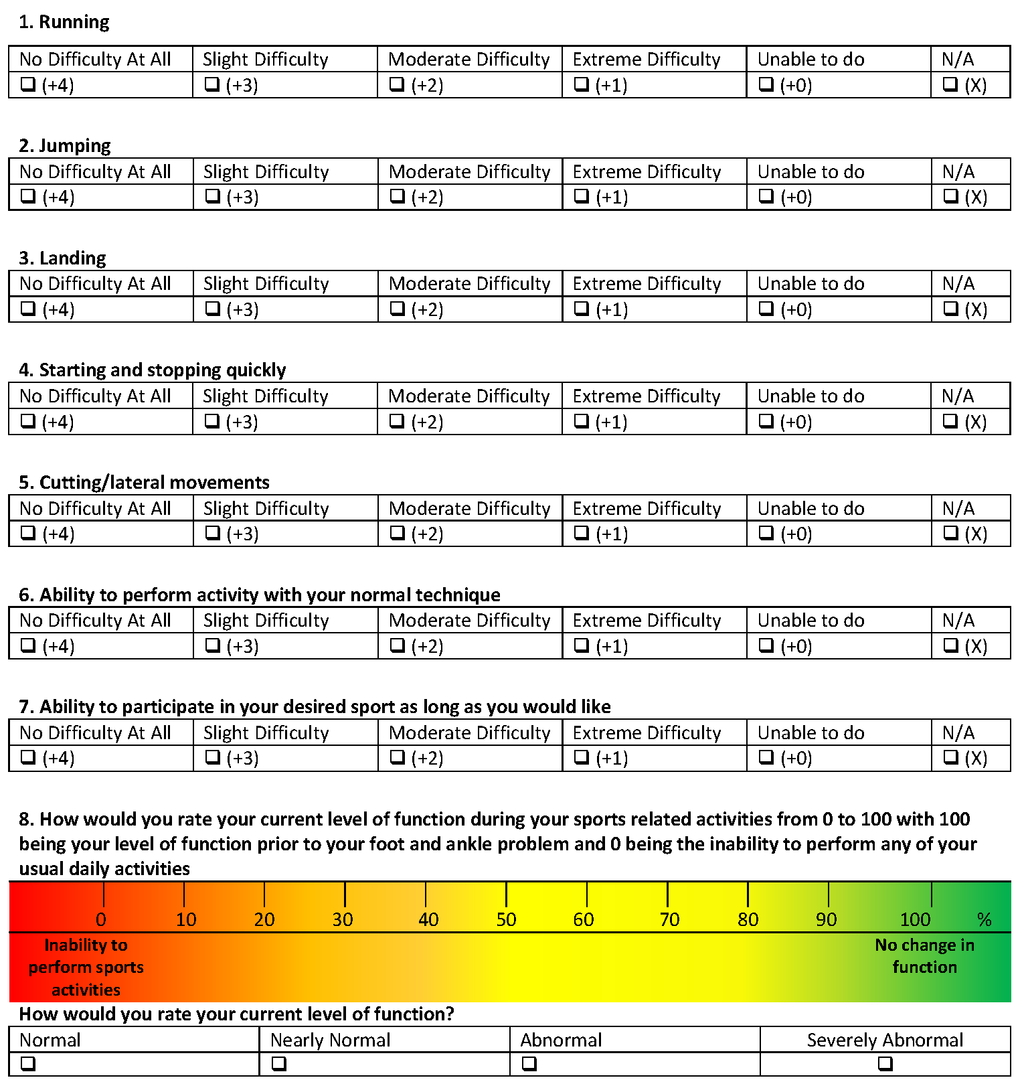8-Item Sports Subscale: Difference between revisions
Kim Jackson (talk | contribs) No edit summary |
Kim Jackson (talk | contribs) m (categorisation) |
||
| Line 1: | Line 1: | ||
<div class="editorbox"> | |||
'''Original Editors''' - [[User:Kim Jackson|Kim Jackson]] | |||
'''Top Contributors''' - {{Special:Contributors/{{FULLPAGENAME}}}} | |||
</div> | |||
== Introduction == | == Introduction == | ||
The 8-items Sports Measure is part of the [[Foot and Ankle Ability Measure|Foot and Ankle Ability Measure (FAAM)]]. The FAAM is a self-report outcome instrument developed to assess physical function for individuals with foot and ankle related impairments. This self-report outcome instrument is available in English, German, French and Persian. The Foot and Ankle Ability Measure is a 29-item questionnaire divided into two subscales: the Foot and Ankle Ability Measure, 21-item Activities of Daily Living Subscale and the Foot and Ankle Ability Measure, 8-item Sports Subscale. The Sports subscale assesses more difficult tasks that are essential to sport, it is a population-specific subscale designed for athletes<ref name="p1">Martin RL, Hutt DM, Wukich DK. Validity of the Foot and Ankle Ability Measure (FAAM) in Diabetes Mellitus. Foot Ankle Int. 2009 Apr;30(4):297-302</ref><ref name="p2">Walmsley et al. The rheumatoid foot: a systematic literature review of patient-reported outcome measures. Journal of Foot and Ankle Research 2010, 3:12.</ref><ref name="p3">RobRoy L. Martin. Evidence of Validity for the Foot and Ankle Ability Measure (FAAM). 2005</ref>. | |||
== The Questionnaire == | |||
Because of your foot and ankle, how much difficulty do you have with:[[File:FAAM 8 item Sports Subscale Table.png|frameless|1088x1088px]] | Because of your foot and ankle, how much difficulty do you have with:[[File:FAAM 8 item Sports Subscale Table.png|frameless|1088x1088px]] | ||
== Scoring the FAAM == | == Scoring the FAAM == | ||
| Line 9: | Line 17: | ||
* The item score total is divided by the highest potential score. This value is multiplied by 100 to get a percentage. | * The item score total is divided by the highest potential score. This value is multiplied by 100 to get a percentage. | ||
* A higher score represents a higher level of physical function. | * A higher score represents a higher level of physical function. | ||
== References == | |||
<references /> | |||
[[Category:Foot and Ankle Examination]] | |||
[[Category:Outcome_Measures]] | |||
[[Category:Ankle]] | |||
[[Category:Foot]] | |||
[[Category:Musculoskeletal/Orthopaedics]] | |||
[[Category:Sports Medicine]] | |||
[[Category:Athlete Assessment]] | |||
Revision as of 19:43, 17 February 2019
Original Editors - Kim Jackson
Top Contributors - Kim Jackson
Introduction[edit | edit source]
The 8-items Sports Measure is part of the Foot and Ankle Ability Measure (FAAM). The FAAM is a self-report outcome instrument developed to assess physical function for individuals with foot and ankle related impairments. This self-report outcome instrument is available in English, German, French and Persian. The Foot and Ankle Ability Measure is a 29-item questionnaire divided into two subscales: the Foot and Ankle Ability Measure, 21-item Activities of Daily Living Subscale and the Foot and Ankle Ability Measure, 8-item Sports Subscale. The Sports subscale assesses more difficult tasks that are essential to sport, it is a population-specific subscale designed for athletes[1][2][3].
The Questionnaire[edit | edit source]
Because of your foot and ankle, how much difficulty do you have with:
Scoring the FAAM[edit | edit source]
- The response to each item on the Sports subscale is scored from 4 to 0, with 4 being “no difficulty” and 0 being “unable to do”.
- If an activity is limited by something other than their foot or ankle is scored as N/A - N/A responses are not counted.
- The scores on each item are added together to get the item score total.
- The number of items with a response is multiplied by 4 to get the highest potential score.
- If the subject answers all 8 items the highest potential score is 32. If one item is not answered the highest potential score is 28, if two are not answered the highest potential score is 24, etc.
- The item score total is divided by the highest potential score. This value is multiplied by 100 to get a percentage.
- A higher score represents a higher level of physical function.
References[edit | edit source]
- ↑ Martin RL, Hutt DM, Wukich DK. Validity of the Foot and Ankle Ability Measure (FAAM) in Diabetes Mellitus. Foot Ankle Int. 2009 Apr;30(4):297-302
- ↑ Walmsley et al. The rheumatoid foot: a systematic literature review of patient-reported outcome measures. Journal of Foot and Ankle Research 2010, 3:12.
- ↑ RobRoy L. Martin. Evidence of Validity for the Foot and Ankle Ability Measure (FAAM). 2005






